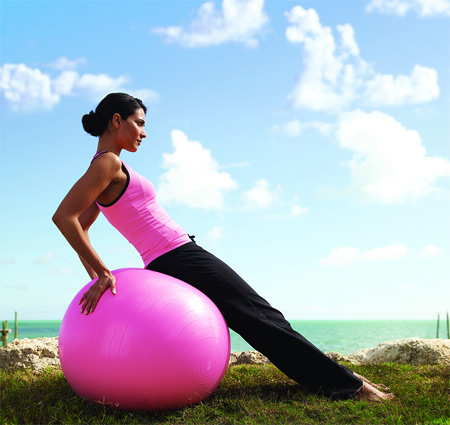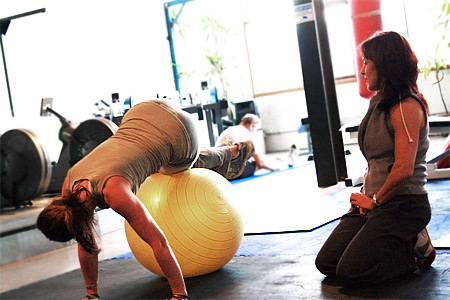Nowadays, fitness industry can offer a good choice of programs. Fitball is one of them. A big ball used when doing this sort of fitness has the same name. Fitball does not overwork your spine and joints. Exercises can be performed at any age and anyplace, in a well-equipped gym or at home. Learn more about fitball below.

The History of Fitball
Fitball originated in the mid 20th century. Physiotherapists contributed to the development of this trend. First, Susan Kleinvogelbach, back in 50-s in Switzerland, studied rehabilitation mechanisms for patients with cerebral palsy and then Joan Posner Mauer (in 80-s, the USA) used ball exercises for rehabilitation of patients with locomotor system injuries.
How Fitball Exericses Work
The main function of fitball is to ease the strain on the spinal column and relieve the joints when needed. As a result, people with joint disorders, varicose veins or excessive weight feel comfortable enough when training. Both the young and seniors are able to do fitball exercises.
Fitball exercises improve your balance skills and precision of movements. As fitball is unstable, you have to actively involve more muscle groups. Basically, they are extensor muscles which serve to support body in upright position and counteract gravity force.
Fitball or Horse Riding?
Experts say that vibration we feel from exercising with fitball is much like riding on a horse in terms of physical impact. Balanced, systematic training with progressively increasing intensity highly strengthens muscle corset around spine, improves blood and lymph circulation as well as boosts metabolism in intervertebral discs. The improvement in spine condition, in its turn, has a positive effect on the function of all internal organs.
Types of Fitballs
Fitballs come in different sizes and withstand static pressure up to 660 pounds. Fitballs are made from extra-heavy PVC material and are designed with BRQ (burst resistant quality) safety system. If punctured or cut accidently, they don’t burst or flatten as air is slowly coming out of the hole.
Fitball Sizes
Fitball’s diameter varies from 17″ to 33″ (45-85 cm) and is chosen depending on height.
- below 60″ (152 cm) – 17″ (45 cm)
- 60″- 65″ (152 -165 cm) –21″ (55 cm)
- 65″-73″ (165 -185 cm) – 26″ (65 cm)
- 73”-80″ (185 – 202 cm) – 29″ (75 cm)
- Above 80″ (202 cm) – 33″ (85 cm)
Make sure fitball doesn’t slide before you begin exercising. When pressed slightly, it should yield about 1″ (2.5 cm) inwards. The less resilient fitball is, the more difficult it is to keep balance. On the other hand, too soft fitball greatly reduces the intensity of exercises.
Fitball Fitness Programs
Fitness program includes a set of exercises performed sitting or lying on a fitball. Right posture is when your body and thighs, thighs and ankles, ankles and feet are at 90 degree angle, head slightly up, back straight, palms flat on the back side of the ball, feet shoulder-width apart and parallel to each other. This position ensures stability and symmetry, which is crucial for maintaining healthy posture.

Sitting exercises develop pelvic muscles and are good for prevention of urogenital disorders like prolapsed uterus and kidney. Lying exercises greatly strengthen back and abdominal muscles. Back and forth swings when you lie on the ball help to relax and ease back pains. Exercises in knee-hand position improve blood circulation in true pelvis organs and ease the spine, thus relieving low back pain.
Source of the image: wikimedia.org, flickr.com/photos/adriarichards.










